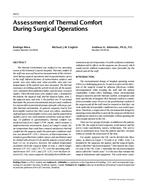Description
The thermal environment was studied in two operating rooms at the Montreal General Hospital. Thermal comfort of the staff was assessed based on measurements of the environment during surgical operations and on questionnaires given to the staff. Infrared pictures of representative surfaces and people were also taken and, when possible, skin and core temperatures of the patient were also measured. The thermal resistance of clothing and the activity levels for all the people were estimated from published tables and previous research studies. Three thermal zones were studied: zone 1, bounded by the patient, the surgical staff, and the surgical lights; zone 2, the adjacent area; and zone 3, the farthest one. It was found that under the present environmental and personal conditions it is not possible to provide all groups of peoplewith an acceptable thermal environment. In general, surgeons tend to feel from slightly warm to hot (they sweat very often), anesthesia staff and nurses fromslightly cool to cold, and the patient from slightly cool to very cold (patients sometimes woke up shivering). In addition to questionnaires, thermal comfort was predicted based on Fanger’s PMV model, which assumes a uniform thermal environment. Based on Fanger’s model, the air temperature that could have ensured satisfactory thermal comfort for the surgeon, under the particular conditions studied, was about 66°F (19°C). However, at that temperature, to remain in good thermal comfort, nurses and anesthetists must be clothed with at least 0.9 clo and the patient covered with at least 1.6 clo. In practice, however, the radiant temperature asymmetry from the surgical lights in zone 1, which ranges between 11°F (6°C) and 13°F (7°C) over the operating table and between 18°F (10°C) and 22°F (12°C) over the floor (at a level of 1.1m), causes surgeons’ dissatisfaction with the environment at any air temperature. Possible solutions to minimize radiation and its effects on the surgeons are discussed, which would permit ambient temperatures more favorable for the patient and all the staff.
Units: Dual
Citation: ASHRAE Transactions, vol. 107, pt. 1
Product Details
- Published:
- 2001
- Number of Pages:
- 11
- File Size:
- 1 file , 330 KB
- Product Code(s):
- D-22511




